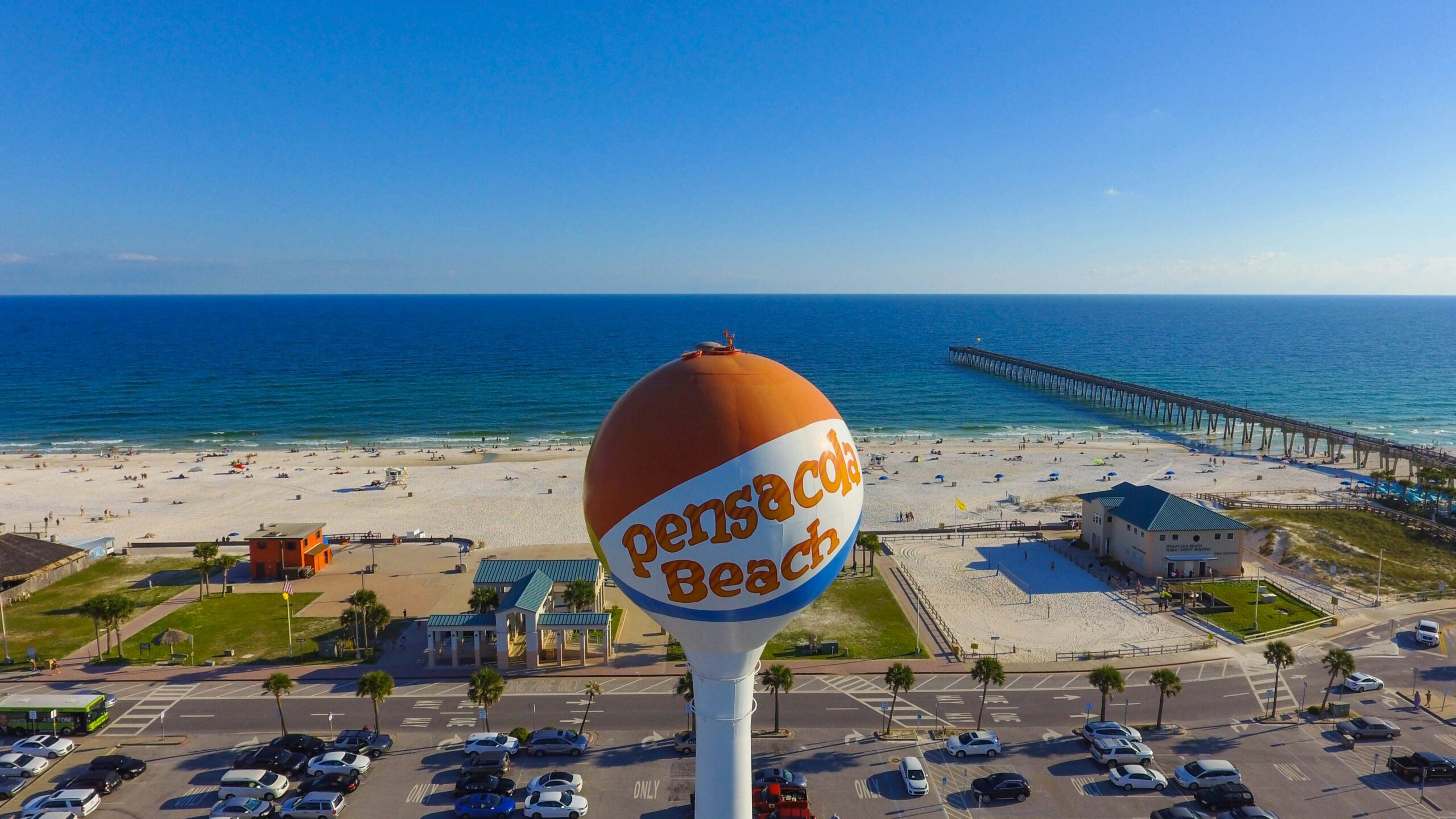The Significance of Pensacola:
Pensacola, a strategic port city in the Florida Panhandle, was a hotbed of military activity leading up to the Civil War. The Pensacola Navy Yard and surrounding forts, including Fort Pickens, Fort Barrancas, and Fort McRee, were key assets that both the Union and Confederacy sought to control. In January 1861, following Florida’s secession from the Union, state troops seized the navy yard and Fort Barrancas, setting the stage for future confrontations.
The Strategic Trio: Fort Pickens, Fort McRee, and Fort Barrancas
Fort Pickens
Location and Design: Situated on the western tip of Santa Rosa Island, Fort Pickens was a key component of the coastal defense system. Its position allowed it to guard the entrance to Pensacola Bay and the Navy Yard.
Significance: Throughout the Civil War, Fort Pickens remained in Union hands, making it a critical outpost for the North in the Confederate-dominated South. Its presence prevented Confederate forces from using the Navy Yard and the bay, significantly impacting their naval capabilities.
Role in Early Tensions: The standoff at Fort Pickens, where Union forces refused to surrender the fort to Confederate demands, was a precursor to the wider conflict. The fort’s strategic location and the determination to hold it underscored its importance in the early days of the Civil War.
Infrastructure: Fort Pickens was a pentagonal, star-shaped fortification constructed primarily of brick. It was designed to withstand naval bombardment and accommodate a large garrison of troops. The fort featured a dry moat, bastions at its corners, and a parade ground in the center.
Batteries: The fort was equipped with numerous cannon batteries positioned along its walls and bastions. These cannons ranged in size and purpose, from smaller field guns to larger seacoast artillery pieces capable of firing at distant targets. The fort’s placement allowed its batteries to cover the entrance to Pensacola Bay, making it a formidable obstacle for any approaching enemy ships.
Fort McRee
Location and Design: Positioned on the eastern tip of Perdido Key, Fort McRee was part of the defensive network protecting Pensacola Bay. Its placement allowed for crossfire with Fort Pickens and Fort Barrancas.
Significance: Fort McRee played a crucial role in the defense of the bay and the Navy Yard. However, it suffered significant damage during the war, particularly from bombardments by Union forces stationed at Fort Pickens.
Role in Early Engagements: The fort was involved in several exchanges of fire with Fort Pickens, highlighting the strategic interplay between the forts surrounding Pensacola Bay. These early engagements demonstrated the contested nature of the region.
Infrastructure: Fort McRee was constructed as a triangular fort with three bastions, each designed to mount heavy artillery. Like Fort Pickens, it was built to be resistant to attack, with thick brick walls and a strategic layout that maximized its defensive capabilities.
Batteries: The fort’s artillery batteries were positioned to provide crossfire with Fort Pickens and Fort Barrancas, creating a deadly zone for any ships attempting to enter the bay. The batteries at Fort McRee included heavy seacoast guns, which were critical in the fort’s role as part of the harbor’s defense system.
Fort Barrancas
Location and Design: Located on the mainland near the Navy Yard, Fort Barrancas was built to protect the entrance to Pensacola Bay. Its design included a water battery, enhancing its defensive capabilities.
Significance: The fort’s proximity to the Navy Yard made it a valuable asset for controlling naval movements in and out of the bay. It was one of the first military installations seized by Confederate forces in Florida, marking an early success for the South.
Role in Early Tensions: The seizure of Fort Barrancas by Florida troops in January 1861 was a significant event that escalated tensions in the region. It demonstrated the determination of the Confederacy to assert control over strategic military assets.
Infrastructure: Fort Barrancas was a masonry fortification that combined traditional brick construction with earthen embankments to absorb enemy fire. It featured a main fort with a central parade ground and a water battery closer to the shore, which provided additional firepower to defend the bay’s entrance.
Batteries: The fort’s main armament was concentrated in the water battery, which housed several large cannons positioned to fire directly at approaching ships. The elevated position of the main fort also allowed for the placement of artillery pieces that could support the water battery and engage targets at a greater distance.
Pre-Fort Sumter Tensions in Pensacola:
The period leading up to the outbreak of the Civil War was marked by increasing tensions between the North and the South, with Pensacola serving as a microcosm of the broader national discord. Several key events and developments in the area heightened the sense of impending conflict.
Secession and Military Preparations:
As states in the Deep South began to secede from the Union following the election of Abraham Lincoln in 1860, Florida was among the first to join the Confederacy. This move set the stage for a showdown over federal properties in the state, including the strategic military installations in Pensacola.
Both Union and Confederate forces began to prepare for the possibility of armed conflict. The Union sought to reinforce its garrisons at key forts, while the Confederacy aimed to assert control over the region’s military assets.
Standoff at Fort Pickens:
Fort Pickens, located on Santa Rosa Island, became a focal point of tension. Despite Florida’s secession, the fort remained under Union control, guarded by a small but determined garrison.
Confederate forces, eager to seize the fort, began to mobilize troops and artillery in the surrounding area. The situation became a tense standoff, with both sides refraining from initiating hostilities but remaining on high alert.
Seizure of the Navy Yard and Fort Barrancas:
In January 1861, Florida state troops took control of the Pensacola Navy Yard and Fort Barrancas, marking an early victory for the Confederacy. This action demonstrated the South’s resolve to take possession of federal military installations.
The loss of the Navy Yard was a significant blow to the Union, as it was one of the best-equipped naval facilities in the country. The Confederacy’s control of the yard allowed them to repair and outfit ships for their nascent navy.
The Case for Pensacola’s Early Shots:
While the bombardment of Fort Sumter in April 1861 is widely recognized as the official start of the Civil War, some argue that the first shots of the conflict were actually fired in Pensacola. This argument is based on several incidents that occurred in the months leading up to the war:
- The Chase of the USS Wyandotte:
- In early 1861, the Union steamer USS Wyandotte was involved in a tense encounter with Confederate forces in Pensacola Bay. As the steamer attempted to resupply Fort Pickens, Confederate batteries fired warning shots across its bow, forcing it to retreat. While this incident did not result in a direct exchange of fire, it demonstrated the willingness of Confederate forces to use artillery against Union vessels.
1) Artillery Exchanges Between Fort Pickens and Confederate Forces:
- The Seizure of the Navy Yard and Fort Barrancas:
- The seizure of the Pensacola Navy Yard and Fort Barrancas by Confederate forces in January 1861 involved the use of force, albeit without bloodshed. The takeover of these strategic locations was a clear indication of the Confederacy’s intent to assert control over federal assets, setting a precedent for future confrontations.
- The Fort Pickens Truce:
- In an effort to avoid outright conflict, a truce was established between Union and Confederate forces regarding the status of Fort Pickens. However, this fragile peace did little to quell the underlying tensions, and both sides continued to prepare for the possibility of war. The truce’s eventual breakdown and the subsequent reinforcement of Fort Pickens by Union forces further heightened the sense of imminent conflict.
- Before the attack on Fort Sumter, there were reports of artillery exchanges between Union-held Fort Pickens and Confederate positions on the mainland. These exchanges were primarily limited to warning shots and attempts to deter further Union reinforcements. While not full-scale battles, these incidents marked an escalation in hostilities and a readiness to engage in armed conflict.



